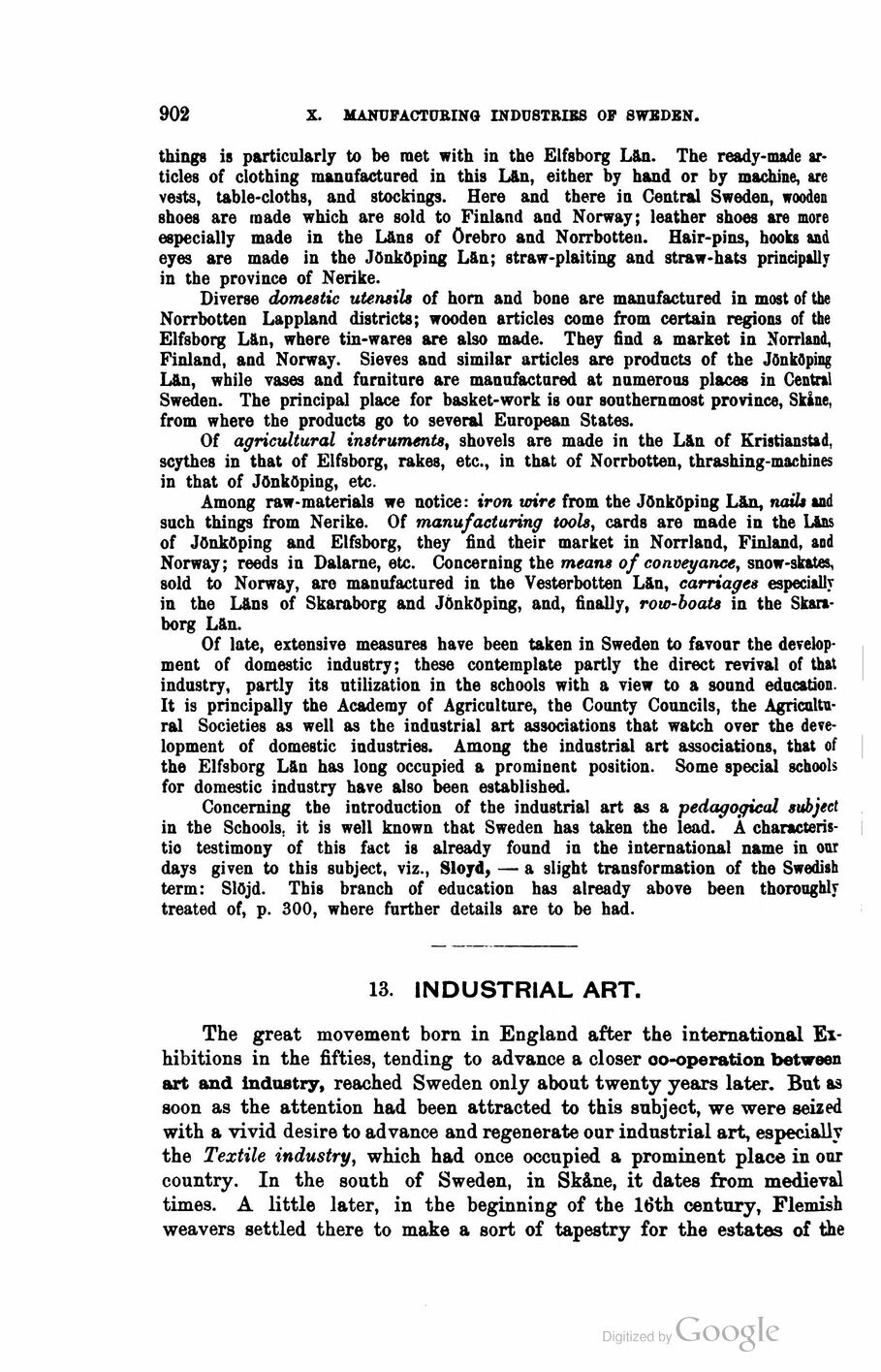
Full resolution (JPEG) - On this page / på denna sida - Second part - X. Manufacturing Industries. By Å. G. Ekstrand, Ph. D., Chief Engineer, Control Office of the Department of Finance - 12. Handicraft and Domestic Industry, by A. Raphael, Ph. D., D. C. L., Stockholm - Domestic Industry - 13. Industrial Art, by Miss Maria Hallman, Ph. C., Stockholm

<< prev. page << föreg. sida << >> nästa sida >> next page >>
Below is the raw OCR text
from the above scanned image.
Do you see an error? Proofread the page now!
Här nedan syns maskintolkade texten från faksimilbilden ovan.
Ser du något fel? Korrekturläs sidan nu!
This page has never been proofread. / Denna sida har aldrig korrekturlästs.
902
X. MANUFACTURING INDUSTRIES OF SWEDEN.
things is particularly to be met with in the Elfsborg Lin. The ready-made
articles of clothing manufactured in this L&n, either by hand or by machine, are
vests, table-cloths, and stockings. Here and there in Central Sweden, wooden
shoes are made which are sold to Finland and Norway; leather shoes are more
especially made in the L&ns of Orebro and Norrbotteu. Hair-pins, hooks and
eyes are made in the Jönköping Län; straw-plaiting and straw-hats principally
in the province of Nerike.
Diverse domestic utensils of horn and bone are manufactured in most of the
Norrbotten Lappland districts; wooden articles come from certain regions of the
Elfsborg Län, where tin-wares are also made. They find a market in Norrland,
Finland, and Norway. Sieves and similar articles are products of the Jönköping
Län, while vases and furniture are manufactured at numerous places in Central
Sweden. The principal place for basket-work is our southernmost province, Skåne,
from where the products go to several European States.
Of agricultural instruments, shovels are made in the Lin of Kristianstad,
scythcs in that of Elfsborg, rakes, etc., in that of Norrbotten, thrashing-machines
in that of Jönköping, etc.
Among raw-materials we notice: iron wire from the Jönköping Làn, nää* and
such things from Nerike. Of manufacturing tools, cards are made in the L&ns
of Jönköping and Elfsborg, they find their market in Norrland, Finland, and
Norway; reeds in Dalarne, etc. Concerning the means of conveyance, snow-skates,
sold to Norway, are manufactured in the Vesterbotten Län, carriages especially
in the Läns of Skaraborg and Jönköping, and, finally, row-boats in the
Skaraborg Län.
Of låte, extensive measures have been taken in Sweden to favoar the
development of domestic industry; these contemplate partly the direct revival of that
industry, partly its utilization in the schools with a view to a sound education.
It is principally the Academy of Agriculture, the County Councils, the
Agricultural Societies as well as the industrial art associations that watch over the
development of domestic industries. Among the industrial art associations, that of
the Elfsborg Län has long occupied a prominent position. Some special schools
for domestic industry have also been established.
Concerning the introduction of the industrial art as a pedagogical subject
in the Schools, it is well known that Sweden has taken the lead. A
characteristic testimony of this fact is already found in the international name in our
days given to this subject, viz., Sloyd, — a slight transformation of the Swedish
term: Slöjd. This branch of education has already above been thoroughly
treated of, p. 300, where further details are to be had.
13. INDUSTRIAL ART.
The great movement born in England after the international
Exhibitions in the fifties, tending to advance a closer oo-operation between
art and industry, reached Sweden only about twenty years later. But as
soon as the attention had been attracted to this subject, we were seized
with a vivid desire to advance and regenerate our industrial art, especially
the Textile industry, which had once occupied a prominent place in our
country. In the south of Sweden, in Skåne, it dates from medieval
times. A little later, in the beginning of the 16th century, Flemish
weavers settled there to make a sort of tapestry for the estates of the
<< prev. page << föreg. sida << >> nästa sida >> next page >>